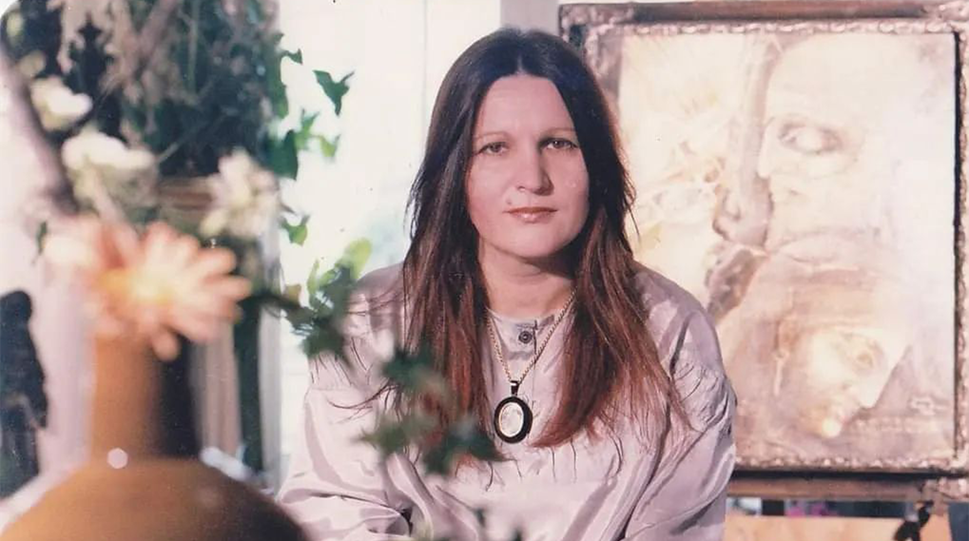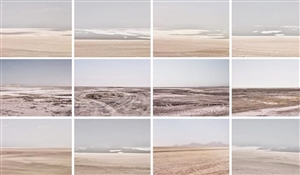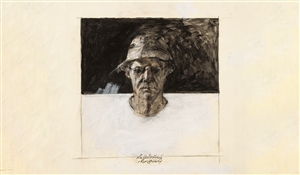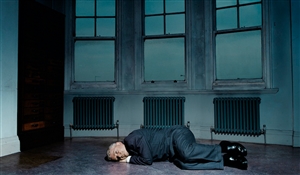A Review of Gizella Varga Sinaei's Life and Artworks
10 Sep 2022Original text in Farsi by Tarannom Taghavi
Translated to English by Omid Armat
Gizella Varga Sinaei's paintings seem like visualized poems, the lines and colors of which display different periods of her life as an immigrant artist. By linking the past and the present and connecting the source and final work, Sinaei brings ancient myths, legends, and old paintings into the context of today's art. She was born in Hungary in 1944, a few months before the Second World War ended. Listening to her father reading her stories of One Thousand and One Nights, her image of the childhood world was shifted from war and destruction toward sweet eastern dreams and the mysterious tales of Aladdin and His Magic Lamp. She got acquainted with the poems of Saadi and Hafez and myths from different nations.
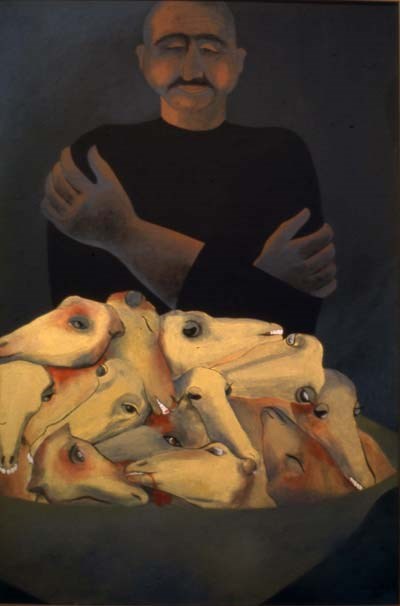
Gizella Varga Sinaei | "Kalle Paz" from "From West to East" series | 120x100 cm | from the collection of the Center Pompidou | courtesy of the artist’s website
Sinaei moved to Vienna after receiving her Diploma. She created paintings with an expressionistic sense while she studied art education at the Academy of Applied Arts in Vienna. During this time, she met Khosro Sinaei. This acquaintance determined the course of events in her life in Iran, a country that led the theme of her works toward Persian literature and mysticism.
Five months after she entered Iran, an exhibition of her works was held in 1968 at Jazeh Tabatabai's New Art Gallery. During the 1970s, she arranged multiple solo shows in Tehran at the (1973), Lautrec Gallery (1974), and Khaneh Aftab Gallery (1977), and she won a prize at the "Mirror in Mirror" exhibition in 1977. Inspired by the ancient sculptures of Persepolis, Sinaei performed a solo show titled "Echo of Silence" (1986) during the first decade of the Iranian Revolution. She taught at the Contemporary Workshop from 1981 to 1987, and since 1988 she worked for 15 years as a school teacher under the German embassy's authority. Arranging two solo shows at Golestan Gallery in 1992 and 1995, becoming a member of the Iranian Painters' Society, Establishment of "Dena Art Group" in 2001, and participating in several solo and group exhibitions during the 2000s and 2010s in Iran, France, Italy, Pakistan, Turkiye, Finland, US, Canada, Hungary, China, and Dubai are among her countless artistic activities.
As an immigrant artist, Sinaei knows very well about Iranian culture, literature, and art and has used them to form the theme of her works. According to the artist, her choice of technique and color in her paintings is based on her feelings and depends on the subject of the work. This indicates the literary value of the subject in her view. On her website, Sinaei has divided her professional achievements into multiple artistic periods:
"From West to East," produced between 1968 and 1977, is the title of a series of Sinaei's works in which her inspiration from the West and the Eastern bloc is visible. Although Western modern art and abstract painting were prevalent among the artists during this period, she kept creating figurative images concerning the daily life of regular people in the streets and different jobs like "Kalle Pazi," ( "Kale Pache" is one of the Iranian traditional dishes served in some special restaurants called "Kale Pazi." ), "Looti Antari," (The act of performing with a monkey) and traditional Iranian ceremonies like "Sizadah Bedar." (Sizdah Bedar also known as Nature's Day is an Iranian festival held annually on the thirteenth day of Farvardin (same as Aries), the first month of the Iranian calendar.) Her next series of works, called "Blind Dolls" (1980), represents her inspiration from Iran's art scene during Iraq's war against Iran and her acquaintance with poems by Omar Khayyam.
For Sinaei, the onset of war was a reminder of her childhood memories, birthplace, and a sense of destruction. She used many different materials like pastels, watercolors, and gouache in the works she created during this period. She rendered her mental image of war with blind, frightened dolls on canvas.
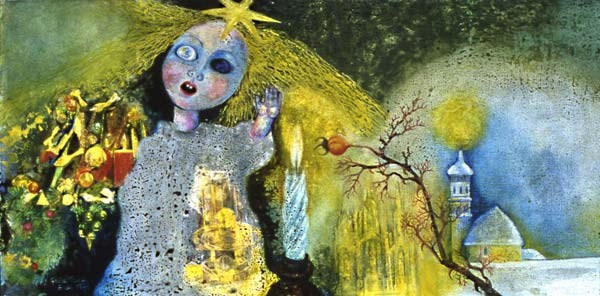
Gizella Varga Sinaei | "Untitled" from "Blind Dolls" series | used as the cover image for the book "Playing Chess with the Resurrection Machine" | 60x40 cm | courtesy of the artist's website
Sinaei said, "after Iraq's war against Iran, one of the strange things that happened to me was that I went on a war tour with Habib Ahmadzadeh. I was shocked during this trip because what we saw of the war was nothing compared to what the people in this region had seen." One of the paintings of Sinaei's "Blind Dolls" series is used as the cover image for Habibzadeh's novel, "Chess with the Resurrection Machine." The image displays a doll on the left side of the painting, with a frightened expression and one eye removed from its socket. The text written by the artist on the back of the book's cover presents her mental image when creating the work: "this painting is an image of my childhood memories, my childhood, and Christmas. The dreams of my parents who wished for better things after the war in Hungary {…} there is still war. I hear explosions near my house, windows tremble, flames rage, people run… and my heart beats anxiously. Will my little angels make it to the home safe?"
Using pastels and sometimes oil paint, the artist has created works inspired by ancient Iranian sculptures and reliefs of Persepolis in her "Echo of Silence" series, formed under the influence of Eastern philosophy, the life cycle concept, and her belief in the possibility of recreation of life.
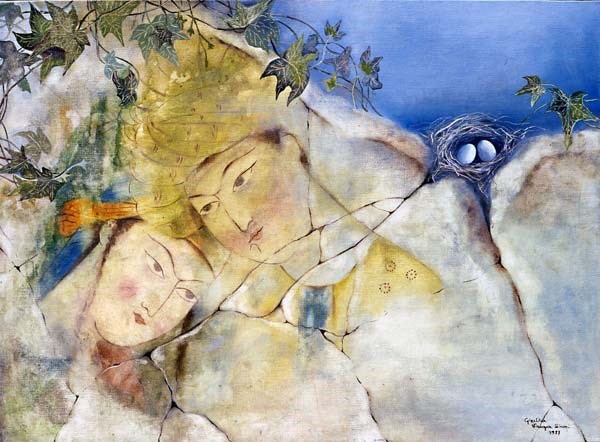
Gizella Varga Sinaei | Couple | from the series "Images and Walls" | oil on canvas | 100x80 cm | courtesy of the artist's website
Swinging between a sense of being and not being, staying and leaving, Sinaei's "Images and Walls" (1989, 2003, 2005) series follows her previous themes and includes pale paintings, residing in a poetic atmosphere influenced by Iranian miniature paintings and Reza Abbasi's works, while being filled with patterns of the mythological fruit, Pomegranate. Some parts of these paintings have been erased to emphasize the essential elements, making the images resemble the appearance of old murals. Sinaei used oil and, later, acrylic paint during this period. Her trip to Qeshm in the late 1990s led to her familiarity with the rich culture of the South, resulting in another series called "The South and its Masks" (1999) containing oil paintings in which the artist has rendered portraits of southern women similar to Greek mythological goddesses along with symbols of fertility, such as fishes and the holy pomegranate, dispersing a sense of blessing and affluence all over the canvas.
When Sinaei became 60 years old, she talked about herself in a series called "Travelogue" (2005). Inspired by Qahveh Khanehei paintings (Qahveh Khanehei painting is an Iranian painting style combined with European techniques (oil and color on wall and convass)) and containing images in enormous dimensions, the series is a visual narration of different periods of Sinaei's life in various places around the world; a magical fabric scroll 15 meters tall presenting images of the artist's life (childhood stories, birthplace, family, war, marriage, Iran, etc.) in great detail. "The Magical Veil" seems like a praying veil from far, but on a closer look, it includes motifs made up of printed portraits of the artist from her childhood to the time of creating the work: her passport picture (Hungarian-socialist passport, which is a symbol of her country), a photo of her with the emblem of the Lion and Sun relating to Iran's flag before the Iranian revolution, and a copy of her national identification card are among these images. In an interview, she describes why she chose a white veil to gather all these symbols and images: "this embraces my feeling for my home country, Iran, and my love for Iran. Traditional Iranian women still wear a white veil with patterns of colorful flowers when they want to go outside the house to do something in the yard or anywhere nearby. This scroll is that same veil, and mine has the magic of time printed on it."
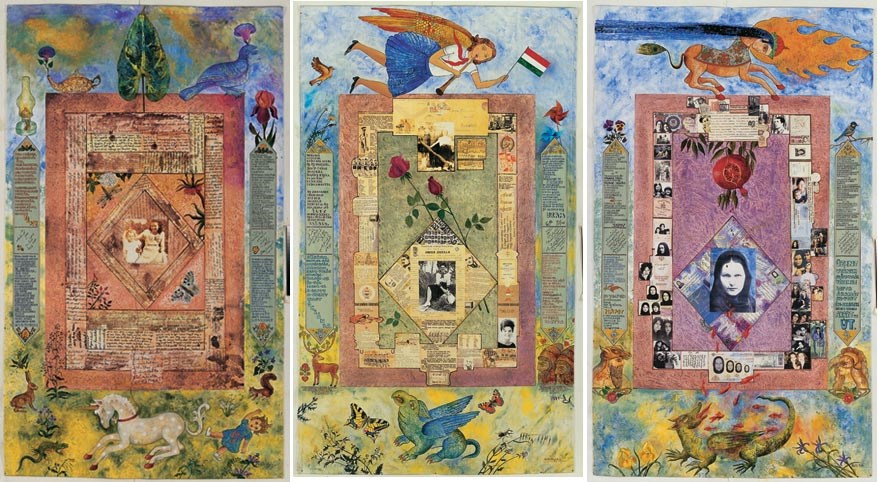
Gizella Varga Sinaei | Travel Book | from the series "Travelogue" | Courtesy of the artist’s website
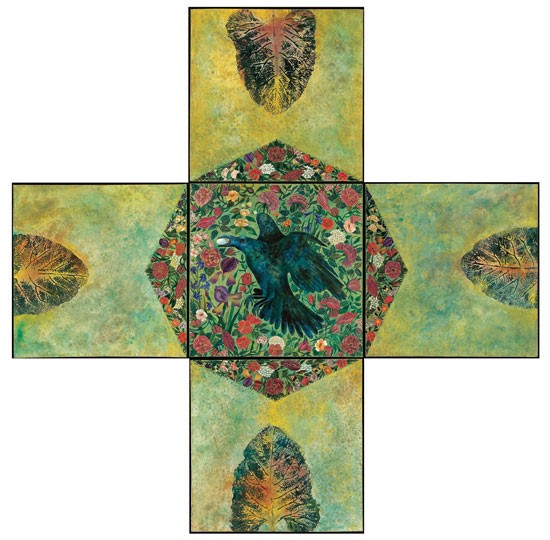
Gizella Varga Sinaei | Untitled | 2010 | acylic on canvas | 90 × 90 cm
Gul o Murgh patterns ("Gol o Murgh" is a style of Iranian miniature painting. "Gul" means flower and "Murgh" means chicken, both symbols of divine grace.) on ancient Iranian tiles and Qalamdan ((plural qalamdans). A Persian box or case for storing a pen) related to the Zand and Qajar dynasties are among the subjects of interest for Sinaei. Viewers engage with her interpretation of a mythical narrative expressed in a modern, innovative way through her creative mind and powerful imagination. Her exhibition at Siin Gallery in 2010 included thirteen paintings, two cleavers, two saws, and six daggers with images of flowers and crows drawn on their surface. Aiming to display contrasting dualities of the world, she rendered the soft, delicate pattern of Gul o Murgh on a sharp, violent knife and replaced Murghs with crows. According to the artist, this contrast "always exists, and beauty acquires its meaning from its proximity to ugliness. One without the other is nonsense; there would be no beauty if we couldn't understand ugliness."
Today, Sinaei's authority originates not only from her art, but also from her view of art as a mass medium for bringing about improvements in the lives of the suffering. Artists who share this view believe art is a cure for sufferers like orphaned or abused children, the elderly, prisoners, patients, addicts, and victims of natural disasters, such as earthquakes and floods, and also human tragedies, such as war, acid attacks and forgotten women in remote areas. Since 2003, the "Omid" foundation has supported and empowered labored children, girls, and women who are victims of rape or violence due to being orphaned or abused. Sinaei taught painting to girls at this foundation and arranged a show titled "Mandalas" (2008) at Dey Art Gallery, displaying her students' results. Works presented at this exhibition, held for one week at the convalescent home for cancer patients, were also put on display in 2006 at a show called "Our Land, Iran" at Pasargadae Gallery. All income from artworks sold at this show was donated to cancer patients at Beham Deheshpour charity foundation and the children supported by the United Nations' World Food Programme. She participated, along with Ahmad Nadalian and Samira Sinaei, in "Persian Gulf Environmental Art Festival" (2007) at Hormoz island. In "Turan Dessert's Life," an environmental exhibition held in 2007, Sinaei presented works following the show's subject, aiming to spread the culture of preserving Iran's environment. In 2011, she won the Parallel Culture Award at the Mediawave festival in Hungary as praise for her efforts and achievements in linking two cultures. Today, her works are stored in the art collection of Pasargadae bank, the Tehran Museum of Contemporary Art, the Quran Museum in Tehran, the Hungarian National Museum, and the Centre Georges Pompidou.
Inja Gallery will host Sinaei's latest solo show, "Under the Helmet," from 9 to 27 Sep 2022. The artist's view about war and its troubles is apparent in the sculptures and installations presented at the show. As she mentioned in the exhibition's statement: "When I was a child, our house in Hungary was near the forest. I was playing with children at the time, when I was paused in front of a grave. It was a small hill with a wooden cross on the top. A metal helmet was laid on the cross. Later, I was found that the grave belonged to a German soldier who passed away in the place and was buried there. The grave was full of grass and wild flowers. The birds were singing over there. In my childhood world, I was thinking of the soldier who died in the forest. Under the helmet, what was he thinking about in the last moment? Was he thinking of his mother, his love or a happy moment in summer time? How he passed his last moment? We are the witnesses of both Iran-Iraq war and Europe war. My grandfather had seen the World War I and II and I was born in the World War II. These helmets remind me those moments. I did not mind thinking of the death of soldiers after they reminded their last seconds, so I painted happy moments of life on the helmets."
Cover and slider image:
- Gizella Varga Sinaei's Instagram account: @gizellavargasinai



